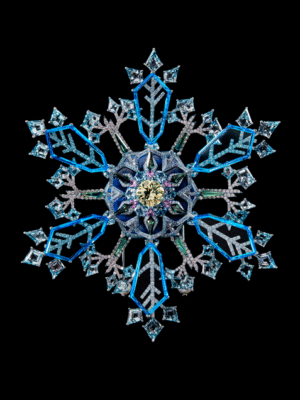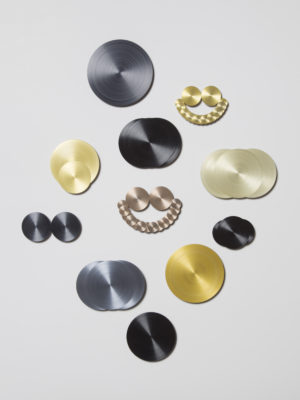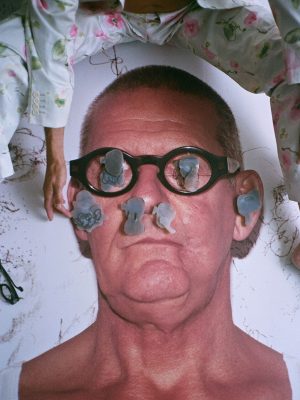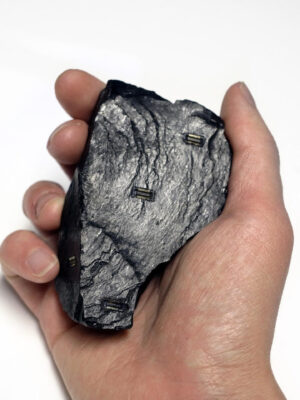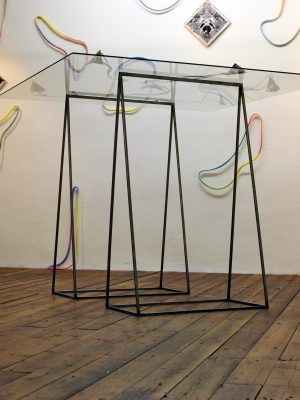Peering through the lustrous layers of one of his jewellery creations is akin to glimpsing another world in microcosm, one teeming with colours, botanical forms and scintillating rays of light that bounce and reflect in more directions than seem possible in our mere four-dimensional universe. It’s as if he has opened a tiny portal into a new, surreal realm where materials have mutated: diamonds take the place of gold, clay is reconstituted to mimic the strength of steel scaffolding, and titanium transmits iridescent colour with the delicacy of a butterfly wing.
___STEADY_PAYWALL___
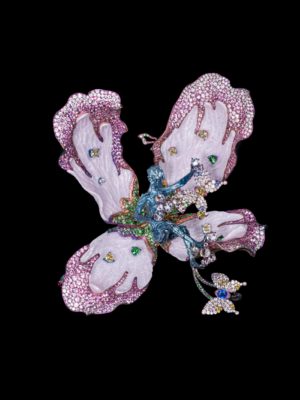
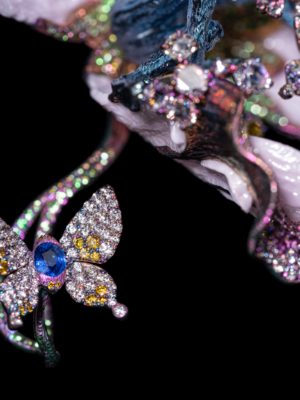
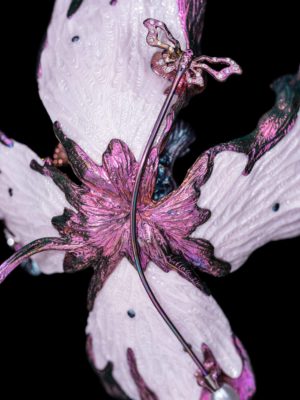
MARINA ELENSKAYA (ME): We are excited that you will be exhibiting your work at the upcoming TEFAF (The European Fine Art Fair), which will be held in Maastricht (7-15 March). Could you tell us about the pieces you are planning to show?
WALLACE CHAN (WC): This year at TEFAF we are going to have a new design for our booth, based off of my childhood memories. When I saw an astronaut when I was young, I imagined that when we saw the reflection in an astronaut’s helmet, we could see the reflection of the universe. Even though the astronaut could not see himself, he could see the universe as a whole. I wanted to transfer that memory to the design of the booth, so we are going to have five showcases, each representing the reflection in the helmet and expressing how the pieces could travel to different planets. One of the creations that will be showcased at TEFAF is a snowflake brooch that will show, through a jewellery piece, what cannot be captured by a camera. It is a unique form of snowflake made with different colours of gemstones in order to express the different images of a snowflake. In this piece, I want to transcend what is not normally made physical.
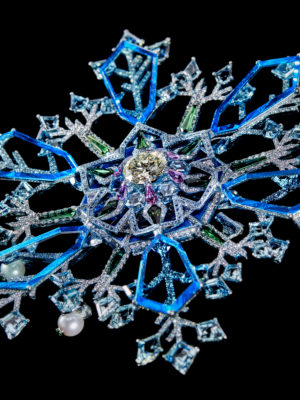
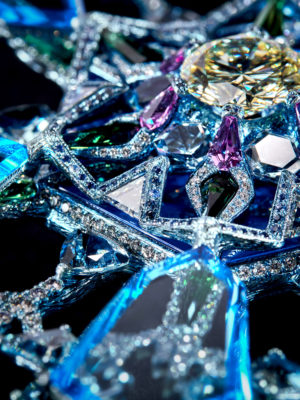
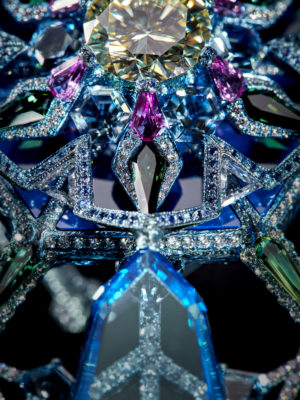
SUZANNE VAN LEEUWEN (SVL): In looking at your work – with its ground-breaking use of materials such as super-strong porcelain, anodised titanium, and precisely carved gemstones – one can see that innovation is one of your driving forces, but do you also look back at the past? Is there a period of historical jewellery in which you are primarily interested?
WC: We are nothing without the past. The foundation that we build upon comes from the people before us, and we would have to start at zero if it weren’t for them! I enjoy all kinds of antiques – teapots, weapons, snuff bottles, furniture, porcelain and marble sculptures. If you want to innovate, you must go beyond your comfort zone. Take knowledge from other fields. Mix it, transform it. That’s how you can help your field evolve and make progress.
SVL: Last year you visited the conservation studios at the Rijksmuseum, where they conserve artist manuscripts and historical manuals from the last few centuries. One of the ways to better understand an object and to preserve it for the future is to learn how it is made. It is very valuable to know what materials and techniques were used by an object’s maker. Are you planning to leave this kind of information for future generations? Or do you think your pieces will stand the test of time and won’t need conservation or restoration work?
WC: I think that this is a wonderful question, but I’m afraid that I don’t have a very good habit of keeping records because much of the creative process happens directly from my mind, to my hand, to my work. If I stop to write something down or draw it out, I lose my train of thought. When I’m creating, I forget about everything outside of creating, so I don’t think about writing things down or making records.
Another thing is that I change my mind and my approach all the time. The end result is always different from what I had in mind originally. It’s very difficult to keep track, but I always create with the goal that the works will stand the test of time. I also wish for my pieces to be teachers, in the sense that people can understand the materials and techniques used to make them by closely observing them.
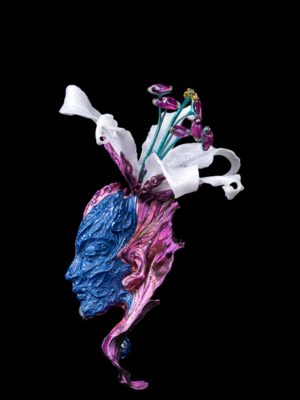
‘When I saw an astronaut when I was young, I imagined that when we saw the reflection in an astronaut’s helmet, we could see the reflection of the universe…’
ME: What gets the concept for a collection started for you? Do you start with a design drawing? With a certain gemstone?
WC: I’ve never thought about designing or creating a ‘collection’. I think that ‘collection’ is more of a fashionable term, and I’m not a fashionable person! Each piece of my creation has a unique theme. Sometimes I’m inspired by a stone, sometimes it may just be an idea in my mind. I try to keep my creative zone as free as possible. The creative process is not a linear process, it’s not a step-by-step kind of thing. Sometimes I’ll be looking at a model and thinking of what I can do with it, coming up with plans for it, but along the way I’ll forget what my original plan was! A lot of things are constantly happening at the same time and sometimes they bring back memories of the past and of different experiences that I’ve had. So, it’s not just focusing on one thing at one moment. I work on many projects at the same time, and as I do that, I just go along with my feelings and sometimes along the way I am inspired by different materials or tools. That new inspiration may lead me to express what I am making differently.
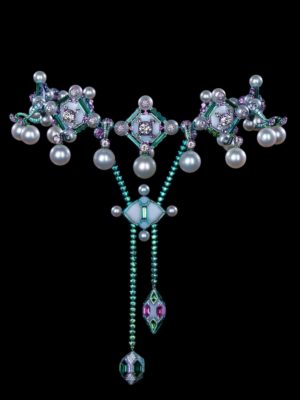
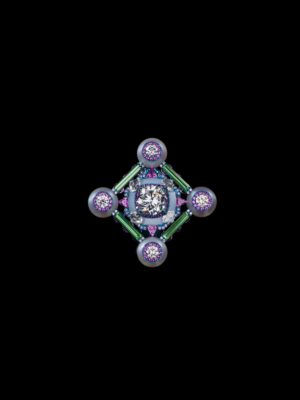
ME: It seems like titanium is your metal of choice, and I saw that you mentioned that titanium is healthier for the human body than other metals. Perhaps you would like to elaborate on what makes titanium so inspiring for you?
WC: ‘Healthier’ may not be a precise enough term, but titanium is known to be bio-friendly and compatible with the human body. I first learned about titanium after reading a news article on the pacemaker, a medical device that stimulates the heart. At the time, I was looking for a metal that would be light enough for me to set bigger stones, but at the same time would not be a burden on the body. Titanium is a very light metal and I can bring many different colours out of it. Depending on what kind of gemstones I want to use in a certain jewellery piece, I can choose what colour I want the titanium to be. That’s the huge advantage of this metal. With the knowledge that titanium is compatible enough with the human body to be made into an implanted medical device, I decided that it would be the right metal for my creations.
SVL: Last year you showed several pieces from your porcelain collection, based on your childhood experience with a broken porcelain spoon. Can we still call the ‘porcelain’material that you have created, even though it is not fragile? How does your jewellery fit into the tradition of cherishing porcelain objects so that they can last for centuries?
WC: The world is filled with love and it’s very important that we learn how to love. If you love something, you would cherish it and handle it with care. Even if it’s just an ordinary cup, you would place it on the table very gently. Jewellery itself is meant to be the embodiment of love, history, culture, memories and emotions. Gemstones are hard, and diamond is the hardest material on Earth, but their hardness does not make us cherish or care about them less.
All the ingredients in the Wallace Chan porcelain are the same ingredients found in traditional porcelain. That didn’t change. But, in order to fulfill my creative desires, I changed its purpose and the way it is manufactured. I needed my porcelain to be hard enough to be the structure of my jewellery creations, and to carry the pieces toward future centuries. Also, the jewellery pieces must be wearable, and comfortable for the wearer, or else they are a failure. So, their structures cannot be made with fragile materials.
The ingredients in traditional porcelain do not meld together very well during the process of sintering because all the ingredients have different melting points. They melt at different moments, making the porcelain fragile. I changed the compositions of the ingredients, their size, the sintering process, the temperature, the length of the sintering, etc, so that those ingredients can mix much better than they do traditionally. That’s why Wallace Chan porcelain is so much harder than traditional porcelain.
I’ll use a metaphor to better explain how my porcelain is still porcelain. When you fire gold, if you leave it to cool at room temperature, it remains very soft. But, if you put it in ice water right after firing, then the gold shrinks and becomes very hard. The hardness changes after the firing process, just like my porcelain. Is it still gold or do we call it something else?
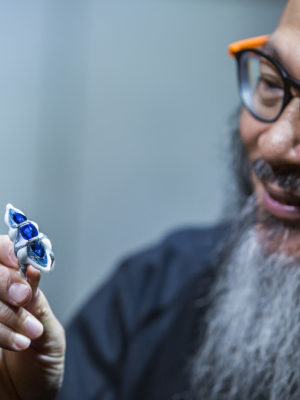
SVL: I read that gold is, indeed, your next project –24k gold with the hardness of 18k gold? Can you tell us more about your research?
WC: I’m a very greedy person, so I’m always working on different projects and research at once. I’ve been working on the gold project for over ten years, even before I started working on porcelain. But the porcelain became successful before I succeeded with this other project. If I tell you more about the gold right now and then something else comes out in two years, then it would be very awkward! Let’s just keep it quiet for now in case I don’t succeed!
ME: It seems that you do a lot of trial and error and learn a lot from your mistakes. I read that you call yourself a ‘master of error’. I really love that! I think it’s good to admit that mistakes happen and that they are a normal part of the creative process. Could you tell us about a mistake that led to something else?
WC: Our failures are our best teachers and success is always built on failures. I never received a formal education, and when I was a young fellow, there was no Google either. So, to acquire knowledge was very difficult. All I could do was experiment and learn from my mistakes and failures. I would take a piece of jade, attempt to cut it, and only end up losing all of its lustrous colour at the end. I would file a patent for my jade refining and brightening technique, only to realise how strenuous the application process was and that it was never worth the time and effort. My life is far from a fairy tale. There was hunger, poverty, loss and grief. I want to show people that it is okay to experience all of these things, and then turn our experiences into something true, kind and beautiful.
SVL: Where are you the happiest? Is it behind the workbench? At a show? Lecturing? Is it difficult to maintain your creativity now that you have become a large brand with a team and are not quietly behind the workbench?
WC: I’m happy wherever I am, whether I’m in my studio, at a tradeshow, or giving a talk and sharing my experiences with other people. But I must say that I’m the happiest when I’m creating and whenever I get to sit down and focus on my creation. It’s like I travel to another planet. I know that I’m far from perfect and that reality is imperfect in itself, but whenever I travel to this ‘planet’, I feel that it is possible to perfect my being.
To me, there is never enough time. Manufacturing must be done in a studio or a workshop, but exercising your creativity is not limited by space or time. I’m curious about everything in the world – I’m always inspired, and I’m always creating. No matter where I am, I’m always inspired by the environment and by the people around me. When an audience member, or anyone comes up to me and talks to me, the conversation itself could eventually become my inspiration for a creation.
I feel that it’s necessary for me to share my experiences while I can. I’m both humbled and honoured by the opportunity to tell my stories. Because I never went to school myself, I have always felt strongly about education. I’m so glad that I’m able to contribute to the lives of others.
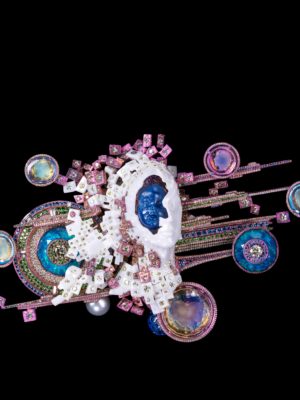
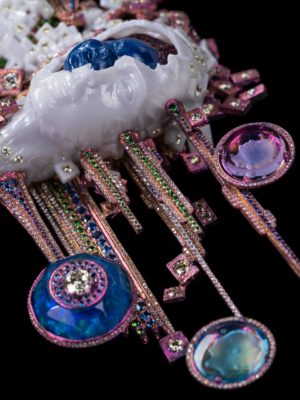
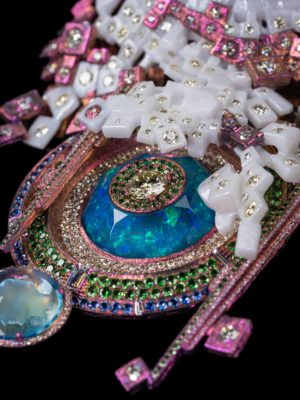
SVL: Hong Kong is the centre of some social upheaval right now. How is that affecting your work?
WC: I’ve always tried to work, not for now, not for yesterday, not for tomorrow, but for history and for the future. Today we are facing all kinds of challenges, but we must never forget the importance of love and empathy. I try to convey this message through my works, and I believe that if I give my works time and attention and the very best of myself, they will stand the test of time to embody love and empathy in the future. There will always be new challenges to overcome. Reality is never perfect, but the world of creativity shows me that in some ways, perfection is attainable. The universe is fast and time is a long, long river. All we have are moments, be them good or bad. But eventually, all of those moments will no longer be. It is just a matter of time before it comes to that, so I try to transcend all of my Earthly desires and emotions through my creations. I create for a time and space far, far away.
‘It could be a jewellery piece, a sculpture, or a piece of installation work. I keep everything I have, regardless of it being used or unused, broken or unbroken.’
ME: Speaking of the future, what do you think about the environmental impact of using precious stones?, If, in the context of your philosophy, you see gemstones as ‘memories of the universe’, how do you feel about questions of sustainability when using them in your work today?
WC: Sustainability is a relatively new term that did not exist in the first few decades of my career. At a young age I experienced poverty, which taught me to cherish everything I have. The best way to do so is to optimise all of my resources. Every creation must be done in the best way possible, so that there is no waste made. During my creative process, I seldom throw things away. If a tool cannot be used for its original purpose anymore, then I turn it into a tool for another purpose. I don’t just throw it away. When I accumulate broken pieces of crystal during the processes of carving, sculpting and experimenting, I turn those broken pieces into another creation. It could be a jewellery piece, a sculpture, or a piece of installation work. I keep everything I have, regardless of it being used or unused, broken or unbroken.
My goal is to create things that will last, hopefully, forever. Gemstones are the memories of the universe because they come from the Earth. They are immortal and are going to outlive all of us. Every gemstone that comes to me should be respected and given the home that it deserves.
ME: I heard that you create a special stand for each of your jewellery pieces so that they can sit as an art object inside somebody’s home or in a gallery. Do you see your pieces more as art objects or do you prefer to see them being worn?
WC: I think that in order to create jewellery, you must be able to find a balance between it being exhibited as an art object and actually being worn. When a piece of jewellery is not worn, it doesn’t have to stay in a safe. It can still be outside and appreciated. I often create a stand or a sculpture to serve as a home for my jewellery pieces. I want them to have a beautiful home to return to when they’re not worn. But again, jewellery is meant to be worn and a piece must be worn in order to come alive with the movements of the human body.
ME: How much can jewellery artists, who are creators of small and intricate objects, impact the world around them?
WC: No matter what profession we engage in, we are human to begin with, so we’re responsible for history and for other people. The most important thing is to keep a good heart, do good deeds, and speak with kindness. Because when you do that, no matter what you do, you impact the world around you in a good way. When it comes to your profession, it’s all about passion and devotion. The impact that we have does not just come from whether the works that we make are big or small, but whether the works leave behind meaning and inspiration for other people.
About the Author: SUZANNE VAN LEEUWEN MA FGA is Junior Curator and Conservator of Jewellery at the Rijksmuseum in Amsterdam. She studied Art History (introduction course), Classical Archaeology and Conservation and Restoration of Cultural Heritage (specialisation in metals), all at the University of Amsterdam. In 2017 she became a Fellow of the Gemmological Association of Great Britain (FGA) after graduating from the Diploma in Gemmology course. In her work at the museum she combines art historical, archival and material research to study the jewellery collection of the Rijksmuseum.
